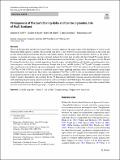Files in this item
Petrogenesis of the Loch Bà ring-dyke and Centre 3 granites, Isle of Mull, Scotland
Item metadata
| dc.contributor.author | Troll, Valentin R. | |
| dc.contributor.author | Nicoll, Graeme R. | |
| dc.contributor.author | Ellam, Robert M. | |
| dc.contributor.author | Emeleus, C. Henry | |
| dc.contributor.author | Mattsson, Tobias | |
| dc.date.accessioned | 2021-07-29T09:30:01Z | |
| dc.date.available | 2021-07-29T09:30:01Z | |
| dc.date.issued | 2021-02-09 | |
| dc.identifier | 273184299 | |
| dc.identifier | 5211743a-a42d-4526-9cdf-3654acd69c0f | |
| dc.identifier | 85100995393 | |
| dc.identifier.citation | Troll , V R , Nicoll , G R , Ellam , R M , Emeleus , C H & Mattsson , T 2021 , ' Petrogenesis of the Loch Bà ring-dyke and Centre 3 granites, Isle of Mull, Scotland ' , Contributions to Mineralogy and Petrology , vol. 176 , no. 2 , 16 . https://doi.org/10.1007/s00410-020-01763-4 | en |
| dc.identifier.issn | 0010-7999 | |
| dc.identifier.other | ORCID: /0000-0003-0717-4014/work/90112880 | |
| dc.identifier.uri | https://hdl.handle.net/10023/23670 | |
| dc.description | The project was supported by Science Foundation Ireland (SFI), the Royal Irish Academy (RIA) and by the Swedish Research Council (VR). Open Access funding provided by Uppsala University. | en |
| dc.description.abstract | The Loch Bà ring-dyke and the associated Centre 3 granites represent the main events of the final phase of activity at the Palaeogene Mull igneous complex. The Loch Bà ring-dyke is one of the best exposed ring-intrusions in the world and records intense interaction between rhyolitic and basaltic magma. To reconstruct the evolutionary history of the Centre 3 magmas, we present new major- and trace-element, and new Sr isotope data as well as the first Nd and Pb isotope data for the felsic and mafic components of the Loch Bà intrusion and associated Centre 3 granites. We also report new Sr, Nd and Pb isotope data for the various crustal compositions from the region, including Moine and Dalradian metasedimentary rocks, Lewisian gneiss, and Iona Group metasediments. Isotope data for the Loch Bà rhyolite (87Sr/86Sri = 0.716) imply a considerable contribution of local Moine-type metasedimentary crust (87Sr/86Sr = 0.717–0.736), whereas Loch Bà mafic inclusions (87Sr/86Sri = 0.704–0.707) are closer to established mantle values, implying that felsic melts of dominantly crustal origin mixed with newly arriving basalt. The Centre 3 microgranites (87Sr/86Sri = 0.709–0.716), are less intensely affected by crustal assimilation relative to the Loch Bá rhyolite. Pb-isotope data confirm incorporation of Moine metasediments within the Centre 3 granites. Remarkably, the combined Sr–Nd–Pb data indicate that Centre 3 magmas record no detectable interaction with underlying deep Lewisian gneiss basement, in contrast to Centre 1 and 2 lithologies. This implies that Centre 3 magmas ascended through previously depleted or insulated feeding channels into upper-crustal reservoirs where they resided within and interacted with fertile Moine-type upper crust prior to eruption or final emplacement. | |
| dc.format.extent | 22 | |
| dc.format.extent | 4432268 | |
| dc.language.iso | eng | |
| dc.relation.ispartof | Contributions to Mineralogy and Petrology | en |
| dc.subject | Centre 3 | en |
| dc.subject | Isle of Mull | en |
| dc.subject | Loch Bà ring-dyke | en |
| dc.subject | Magma mixing | en |
| dc.subject | Magma–crust interaction | en |
| dc.subject | GE Environmental Sciences | en |
| dc.subject | Geophysics | en |
| dc.subject | Geochemistry and Petrology | en |
| dc.subject | DAS | en |
| dc.subject.lcc | GE | en |
| dc.title | Petrogenesis of the Loch Bà ring-dyke and Centre 3 granites, Isle of Mull, Scotland | en |
| dc.type | Journal article | en |
| dc.contributor.institution | University of St Andrews. School of Earth & Environmental Sciences | en |
| dc.identifier.doi | 10.1007/s00410-020-01763-4 | |
| dc.description.status | Peer reviewed | en |
This item appears in the following Collection(s)
Items in the St Andrews Research Repository are protected by copyright, with all rights reserved, unless otherwise indicated.

